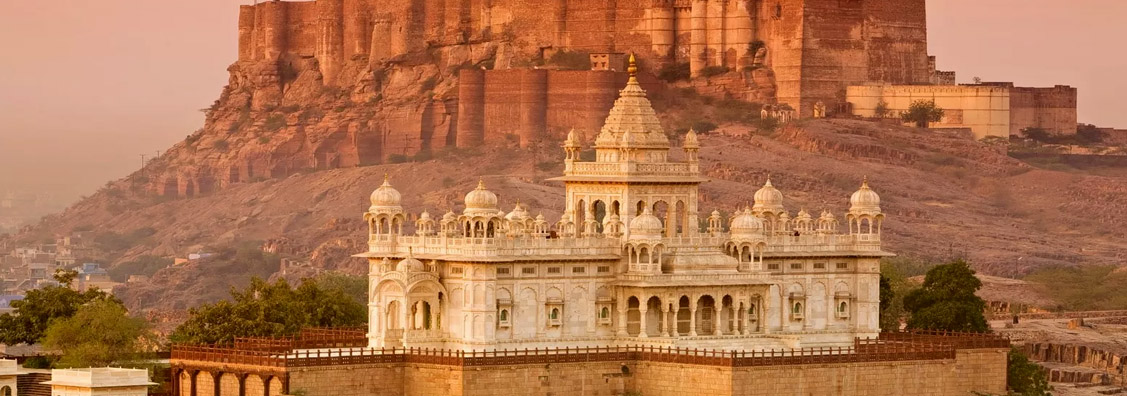

Home / Attractions / Jodhpur
Jodhpur, city, central Rajasthan state, northwestern India. It is situated just northwest of the Luni River on a sterile tract of land covered with high sand hills. The region is sometimes referred to as Marwar (derived from maru-war ["region of death"] because of the area's harsh desert conditions). Its north and northwest areas form part of the Thar (Great Indian) Desert.
Jodhpur is a major regional road and rail junction and a trade centre for agricultural crops, wool, cattle, salt, and hides. An airport handles domestic flights. The city has engineering and railway workshops and manufactures cotton textiles, brass and iron utensils, bicycles, ink, and polo equipment. Jodhpur is famous for its handicraft products, which include ivory goods, glass bangles, cutlery, dyed cloth, lacquerwork, felt and leather products, marble stonework, and carpets. Tourism is an important component of the city's economy.
Jodhpur, the second largest city of Rajasthan, is the seat of the Rajasthan state high court. It's Population was counted about 1.3 million in year 2018. The city is the site of an air force college, the University of Jodhpur (established 1962), and a medical college affiliated with the University of Rajasthan in Jaipur (the state capital). Parts of Jodhpur are surrounded by an 18th-century wall. Mehrangarh Fort, which contains the maharaja's palace and a historical museum, is built on an isolated rock eminence that dominates the city. The 4th-century ruins of Mandor, the ancient capital of Marwar, lie immediately to the north. In addition to the fort, Jodhpur's other notable buildings include the Umaid Bhawan Palace, the home of the Jodhpur royal family and also a luxury hotel, and the white marble Jaswant Thada, a memorial to the 19th-century ruler Jaswant Singh II.
The city was founded in 1459 by Rao Jodha, a Rajput (one of the warrior rulers of the historical region of Rajputana), and served as the capital of the princely state of Jodhpur. The princely state had been founded about 1212, reached the zenith of its power under the ruler Rao Maldeo (1532–69), and gave allegiance to the Mughals after the invasion of the Mughal emperor Akbar in 1561. The Mughal emperor Aurangzeb invaded and plundered the Marwar region in 1679, ordering the conversion of its inhabitants to Islam.
The princely states of Jodhpur, Jaipur, and Udaipur formed an alliance, however, and prevented control by the Muslims. The Jodhpur and Jaipur princes then regained the privilege of marriage with the Udaipur family—which they had forfeited when they allied with the Mughals—on condition that children of Udaipur princesses be first in succession. Quarrels resulting from that stipulation, however, finally led to the establishment of the supremacy of the Marathas, a Hindu warrior caste.
In 1818 Jodhpur came under British paramount. It was the largest princely state in the Rajputana Agency—the British governing entity in the region—occupying much of the central and southwestern portions of what is now Rajasthan state. It joined Rajasthan in 1949.
Now let's focus of Jodhpur Attraciton…
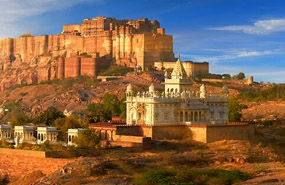
Mehrangarh Fort holds the pride of place in Jodhpur because of its splendid architecture and the diverse history associated with it. Considered as one of the most formidable and magnificent forts of Rajasthan, Mehrangarh fort was built by Rao Jodha in the year 1459. The fort is spread over an area of 5 km and is built on 125 m high hill in the outskirts of Jodhpur city.
There are seven gates, which can be used to enter the Mehrangarh fort. These 7 gates are made by different rulers, and are built in honour of victory over Bikaner and Jaipur armies.
One can see the panoramic view of the Jodhpur city from this fort, which seems like a blue carpet laid at the foot of a hill. Every ruler of Jodhpur has contributed in the making of this fort. Within the fort one can see the magnificent palaces. The main palaces located in the Mehrangarh Fort are Moti Mahal, Phool Mahal, Sheesh Mahal, Zenana Dude, Takht Vilas and Jhanki Mahal. There are also two temples located inside the fort - Chamundi Devi Mandir and Nagnechiaji Mandir, dedicated to Goddess Durga and the Kuldevi respectively.
There is also a museum within the Mehrangarh fort, which exhibits a rich collection of palanquins, musical instruments, royal cradles, costumes, arms, furniture and paintings.
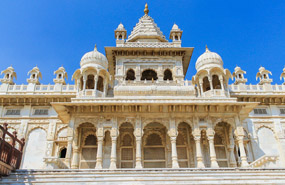
To the left of the Mehrangarh Fort complex is the Jaswant Thada of Jodhpur, Rajasthan. It is a 19th century royal cenotaph built in commemoration of Maharaja Jaswant Singh II, the 33rd Rathore ruler of Jodhpur. The son of Maharaja Jaswant Singh, Maharaja Sardar Singh, in the memory of his father, built the Jaswant Thada. The cenotaph has two more tombs within it. Near to this are the royal crematorium and three other cenotaphs.
Famous Jaswant Thada in Jodhpur, India is an example of architectural brilliance in India. It is a white marble memorial, built out of intricately carved sheets of marble. The carving shows the genius of the sculptors. These stones are extremely thin and polished. As a result, the outside surface of the monument emits a warm glow when the sunrays fall on its surface. There is also beautiful marble jali work on the cenotaph. You can have some nice views from the terrace in front of the cenotaph.
The cenotaph of Maharaja Jaswant Singh displays portraits of the rulers and Maharajas of Jodhpur. The main memorial has been built like a temple. To visit the Thada you have to go through the rocky hills. This also lends a mystic aura to the whole visit. Do make sure to visit this architectural delight while on a tour to Jodhpur, Rajasthan.
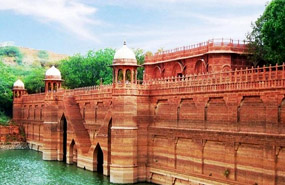
A stone's throw away from the ancient capital of Marwar, Mandore, and only 8 km from the city-center of Jodhpur, Bal Samand is a world away from the hustle and bustle of modern life. The lake was engineered in the 12th Century but the exquisite red sand-stone palace came later; it was built by Maharaja Jaswant Singh I of Jodhpur in the 17th Century, at the very zenith of Rathore Rule under the umbrella of the Mughal Empire. Set in a private estate of over 60 Acres, with sprawling orchards of lime and pomegranate and landscaped gardens criss-crossed by elegant waterways and even a aqueduct, the palace with its lovely promenade on the lake, was always more than just a residence; a pleasure palace in the finest Mughal tradition of the picnic. In more recent times a tradition has developed with the Royal Family celebrating the first rains in Bal Samand; a custom that has led to the palace being referred to as a Monsoon Palace. But today, after the successful completion of an ambitious restoration and modernization program Bal Samand is the palace for all seasons; a world class Heritage Hotel with modern amenities.
The Palace located near lake, having suite rooms. Only one suite i.e. Maharani suite is facing lake . Each is tastefully and luxuriously appointed in authentic Jodhpur style, with traditional seating, dining alcoves, chaise lounges by the window and enormous jacuzzi baths. The gracious interiors are matched only by the spectacular views of the pristine lake and the splendid gardens.
Down in the gardens, surrounded by acres of manicured lawn, are twenty six tastefully designed Garden Rooms with their own Rose Garden, croquet lawn and restaurant.
Bal Samand Garden Retreat & Lake Palace is one hotel & two wings.
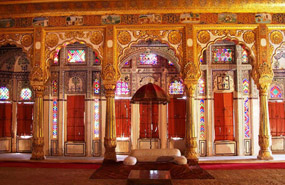
The Phool Mahal is a beautifully decorated hall in the Mehrangarh fort, Jodhpur. The hall probably served the purpose of a pleasure dome of the Maharajas, and the female dancers used to stay here. Accordingly the room was made to look as beautiful as a magnificent flower, which earned it the name Phool mahal. The ceiling has golden filigree work, for which it is said, gold was brought from Ahmedabad, Gujarat. There are also some beautiful portraits and paintings, especially the raga mala series, and furniture from the British period to enhance the glory of the room.
HISTORY OF THE ATTRACTION
The room was built by Maharaj Abhaya Singh, who ruled in this region from 1724 to 1749. He built this room from the gold from Ahmedabad, which he brought in as the spoils of the war with Sarbuland khan, who was a Mughal governor who had rebelled.
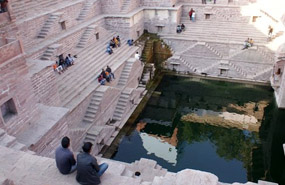
Toorji Ka Jhalra (Toorji's Step Well) was built in Jodhpur the 1740s by a Queen, Maharaja Abhay Singh's Consort, continuing an age old tradition that Royal women would build public water works.
As with all step wells, the steps follow the fluctuating water table down to provide easy all-year round access. Interestingly this well was submerged and full of debris for decades. Only recently has it been drained, cleaned up and restored.
In the process, the excavations went down over two hundred feet to expose hand carved treasures in Jodhpur's famous rose-red sandstone; including intricate carvings of dancing elephants, medieval lions and cow water-spouts, as well as niches housing deities long gone.
The well's original system consisted of a Persian Wheel driven by a pair of bullocks circling the platform on top, which drew water up to two different
access levels and a separate tank. The whole area around the Toorji Ka Jhalra step well has undergone a bit of urban regeneration recently, under the
auspices of a project called JDH, with vibrant shops, restaurants, hotels and cafes. Even though Toorji Ka Jhalra is just a few hundred meters from
the Clock Tower in Jodhpur, the step well still seems to be largely off the tourist map, which I was quite surprised about. I guess available time and the
draw of the Mehrangarh fort prevents more visitors from coming here.
The best time to see the well is probably early morning, by midday it's always frequented by children and some adults who enjoy having a dip and a dive into what must be extremely cool waters. It's great to see the local community embracing this heritage monument once again.
The daily maintenance of the well is purely through volunteers, and they do a great job. The water must be pretty clean as there's plenty of fish swimming around the tank, who of course get regularly fed by the locals.
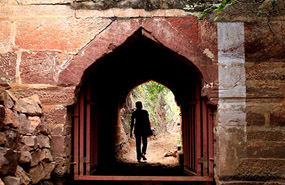
Rao Jodha Desert Rock Park is located at the foot of Mehrangarh Fort. It was created in 2006 for restoration of natural ecology of rocky wasteland. This sandy desert park has rock loving plants which adapts to the arid surrounding. It was opened to the public in February 2011. The area in and around the park contains distinctive volcanic rock and sandstone formations. The park includes a Visitors Centre with Interpretation Gallery, a native plant nursery, small shop and cafe. There are four trails (yellow, green, red, and blue trails), about 880 m to 1115 m long, that visitors can take and trained guides and naturalists are also available.
The park has a native plants nursery where native rock-loving and arid region plants are propagated from seeds and cuttings. The nursery is located near the 'piao' or public drinking water station on the way down from the fort. The seedlings raised here are planted out for ecological restoration of the park area each year around the monsoon. Over 80 native plant species have been raised and planted out in the park.
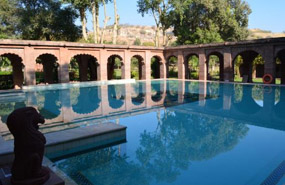
Balsam Lake Mountain is one of the Catskill Mountains, located in the Town of Hardenburgh, New York, United States. It is the westernmost of the range's 35 High Peaks. Its exact height has not been determined, but the highest contour line on topographic maps, 3,720 feet (1,130 m), is usually given as its elevation.
Located within the Balsam Lake Mountain Wild Forest management unit of the Catskill Park Forest Preserve, in the late 19th century its summit became the site of the first fire lookout tower in the state, operated by members of a nearby sportsmen's club. It was later taken over by the state's conservation agencies, which built several improved towers on the site, one of which remains, along with its accessory buildings and has been listed on the National Register of Historic Places, although it has not been used for fire detection since 1988. The summit is also the site of a rare sphagnum bog that has been affected by acid rain since a mid-20th century windstorm blew down many of the trees sheltering it at the time.
The tower and the views it commands, as well as its ease of access by the old truck road to the tower, have made it a popular attraction for hikers despite the mountain's remote location. Many are peakbaggers aspiring to membership in the Catskill Mountain 3500 Club, for which Balsam Lake is a required peak.
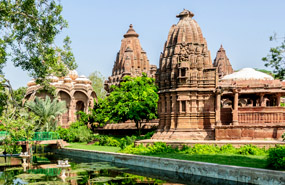
History of Mandore gardens starts from the 6th century. At that time Mandore was under the rule of Pratiharas of Mandavyapura. The king of Rathore dynasty Rao Chunda married the Princess of Pratiharas. As a dowry, he got the Mandore Jungarh Fort.
After a while, In 1427 Mandore under the rule of Rao Rinmal Rathore who is also the administrator of the kingdom of Mewar until 1438. The Mewar ruler Rana Khumba overtook the throne of Mandore by assassinating the Rao Rinmal. During the assassination of Rao Rinmal his son escaped and tried a lot to recapture the Mandore but not worked. In 1453, Mandore underwent the rule of Rao Jodha.
After many invasions, Mandore became the capital of Jodhpur kings. Even though many dynasties invaded the Mandore like Muslim rulers of Gujarat and Malwa. To protect the Mandore, the capital of Jodhpur was changed to Mehrangarh Fort which is safe for the kingdom wealth.
This is the history of Mandore in Jodhpur. Even though it faced many invasions, it was there for us to experience the bygone era of Jodhpur through the architectural styles and royal cenotaphs.
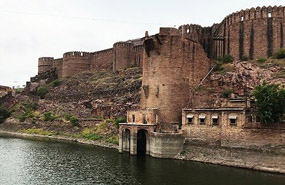
The Ranisar and Padamsar lakes are two adjoining lakes in the city of Jodhpur built over 500 years ago. They are situated at the rear of the Mehrangarh Fort, near the Fateh Pol. These scenic lakes were created to conserve water, as Jodhpur falls under a desert region where water is scarce. The tranquillity of these adjacent lakes is complemented brilliantly by the stark contrast of the majestic Mehrangarh Fort, making it a sight to behold. The clear waters have been preserved and maintained for centuries, providing a serene vibe and an almost identical reflection of the grand fort on its surface. The development of the two lakes was commissioned by two different queens in the 15th century. Ranisar lake was made on the orders of Queen Jasmade Hadi, wife of Rao Jodha, the founder of Jodhpur. Padamsar lake was created by Queen Padmini, the daughter of Rana Sanga of Mewar. These lakes were built to conserve water in the desert region, serving as excellent examples of the age-old tradition of royal women being in charge of overseeing the public water systems. They represent the classic water storage systems that are ever present throughout this region. They are considered a consistent source of water in the city.
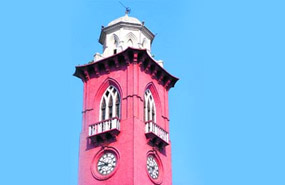
A major landmark of Jodhpur, the area around the Clock Tower or Ghanta Ghar , is a vibrant market place and offers its visitors an exciting shopping experience. You can shop here for the finest variety of spices.
The century-old clock tower is a city landmark surrounded by the vibrant sounds, sights and smells of Sardar Market. The market is bordered by triple-arched gateways at its northern and southern ends. The narrow, winding lanes of the old city spread out in all directions from here. Westward, you plunge into the old city's commercial heart, with crowded alleys and bazaars selling vegetables, spices, sweets, silver and handicrafts.
